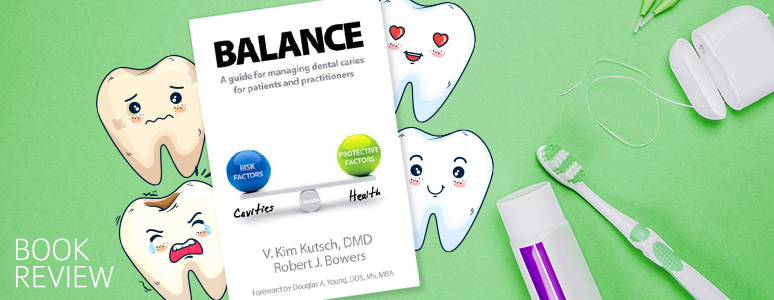
Book Review: Balance: A Guide to Managing Dental Caries for Patients and Practitioners
Where can I get this book?
It’s available on Amazon in paperback or Kindle format
click here to buy Balance: A Guide to Managing Dental Caries for Patients and Practitioners
We had mixed feelings when ordering a copy of this book – it appeared really professional and promising, but it was already 7 years old and after this, quite a long time it had only 7 reviews on Amazon (100% positive though) compared to staggering 923 reviews of the most popular in the category Cure Tooth Decay by Ramiel Nagel. This imbalance (pun intended!) suggested that there may be something wrong with this guide. Let’s say it out loud: there’s not!
There are many pop-science dental books on how to avoid or cure dental cavities available on the market. These books, which usually claim more than they actually deliver, are often based on their author’s own research and observations. This book, by V. Kim Kutsch and Robert J. Bowers, is totally different – it uses actual science as a starting point. As medicine, in general, is turning into the evidence-based model (called EBM) we are thrilled to see that ADA is supporting the Evidence-Based Dentistry movement.
Please note: both authors are entrepreneurs running a company that sells dental products under CariFree brand. Their products are designed strictly to prevent cavities and the authors have decided to do some kind of an advertorial putting both company's name, website address, and product list with pricing in their book. We have not tested their products and this review is only regarding their book.
So what exacly is Evidence-Based Dentistry and CAMBRA?
Whole concept of this book is around CAMBRA* which stands for Caries Management by Risk Assessment. It is a brilliant idea for the preventative form of dentistry, in which every patient is categorized into a risk group (low, moderate, high, extreme) based on their personal factors – both risk and protective. Knowing the group you belong to tells you how aggressive your anticavity efforts and interventions should be and how often should you have your checkups and x-rays. You should get this knowledge straight from your dentist but since not all dentists are familiar with CAMBRA why not educate yourself on your own?
Let us state it clearly: As of 2020, this is the most underrated book on dental caries on the market. Want to read on this subject? Start here.
Most important takeaways from this book
If you’re unable to get your hands on this book here are some important ideas. As the title suggests it’s all about keeping the right balance between risk and protective factors.
Risk factors for caries that support demineralization:
- biofilm imbalance (unhealthy or too much plaque) – which can be tested by plaque-disclosing dye tablets or CariScreen swab test
- dry mouth and not enough saliva (xerostomia) due to medications or lifestyle factors like stress, poor diet, disease, age or heredity
- frequent snacking – which cause prolonged pH drops below critical values
- improper mouth care – related to lack of guidance from dental professionals
- oral appliances – this category refers to othodontic treatment but also all kinds of mouth guards, night guards, Invisalign aligners and partial dentures
- other health problems – smoking, diabetes, acid reflux, bulimia, radiation therapy, Sjögren syndrome and drugs use
Protective factors that support remineralization:
- pH neutralization – critical pH level when enamel demineralization starts is 5.5, if you want your biofilm to be healthy you should avoid low pH levels or at least shorten their duration; also make sure if your mouth rinses are not low pH ones
- fluoride – fluoride can make your teeth more resistant to acid attacks lowering critical pH level when enamel demineralization starts to 4.5
- xylitol – when combined with fluoride in mouth care products it provides synergistic effects
- antibacterial – only free-floating bacteria can be easily killed, to get rid of structured biofilm bacteria you need potent oxidizing agents like sodium hypochlorite
- nanohydroxyapatite and calcium phosphate ions – these are biomimetic interventions, aimed at delivering particles that occur naturally in saliva
CariScreen – scientific way to measure your progress
Let’s say you rigorously followed advice from the book and would like to receive feedback if you’re on the right track or not – until now the only way was to observe white spot lesions remineralization or just count new cavities every time you have your scheduled checkup appointment. Now there’s a new scientific method to do just that – it’s called CariScreen and it’s a form of numeric assessment of your biofilm quality. It is a form of a quick swab test that gives you a certain number between 0 and 9999 – generally the lower the better, but values below 1500 are considered healthy. Balance book contains real patients cases and each of these cases is presented with their ATP CariScreen scores to show that the methods presented in the book really work – the reader can observe scores go both up and down after adding more protective factors or changing habits for worse.
To sum up – this is a very good medical book, suitable for both dentists and patients who want to educate themselves on managing caries risk. Since it’s a dentistry book you won’t read about oil pulling, diet, and other alternative approaches, but it’s a perfect book to semantically build knowledge on how decay forms and how to prevent it. We hope the book gets updated since now we have more knowledge of dental probiotics, bacteria, etc.
What’s good:
- solid science based on EBD (Evidence-Based Dentistry)
- short format without unnecessary descriptions
- patients case studies presented
- the fact that there is no better book regarding this matter is a huge plus
What’s bad:
- focuses mostly on oral routine, without diet recommendations
- book may be a bit too technical for a typical patient
- repetitive from time to time, but obviously the author is a clinician, not a novelist
The bottom line:
Overall, we give this book strong 4.5 stars out of 5 – if you want to read one book to understand dental caries well this is the one. It explains well both risk factors and protective factors for caries and thus giving you a clear path to recovery. While it may be a bit too technical and does not address many general aspects of oral health, it’s perfect if you want to understand why you keep getting cavities and what can you do about it.
Where can I get this book?
It’s available on Amazon in paperback or Kindle format
click here to buy Balance: A Guide to Managing Dental Caries for Patients and Practitioners
Important 2021 updates: it’s free to read + there’s a new book!
Two important updates:
1. You can now read this great book for free! Just visit CariFree website (it’s a manufacturer of dental products owned by the author of the book), then go to Shop section and click on the book (which is listed for $0.00) and finally click View ebook button. The book in paperback format can be also added to your CariFree order for free!
2. The author has published another book, this time intended for patients rather than clinicians. The book title is: Why Me? The unfair reason you get cavities and what to do about it and it’s available on the same website to read online, download, or order a free paperback copy when purchasing their products.
Disclaimers: 1. Please note that this book was published in 2012, so this is a late review, but since it is one of the very best publications on the subject we just had to review it to increase awareness. Our review is based on the 2nd edition, paperback format, published in 2012. 2. Please note, that CAMBRA is a registered trademark of the University of California, San Francisco. 3. As Amazon Associates, we earn from purchases made using our affiliate links.
This book reviewis complete and was published on December 22, 2019, and last updated on June 7, 2023.



